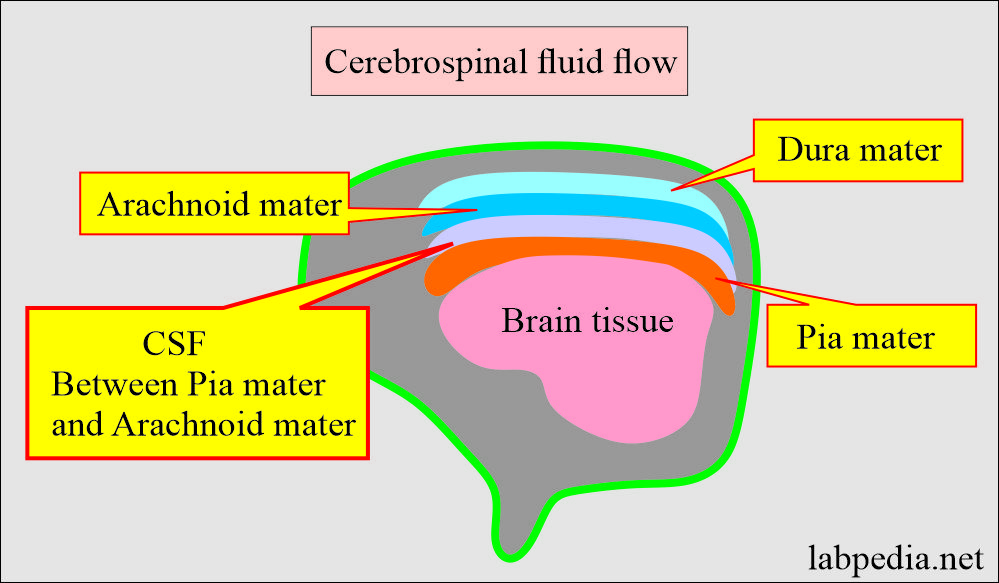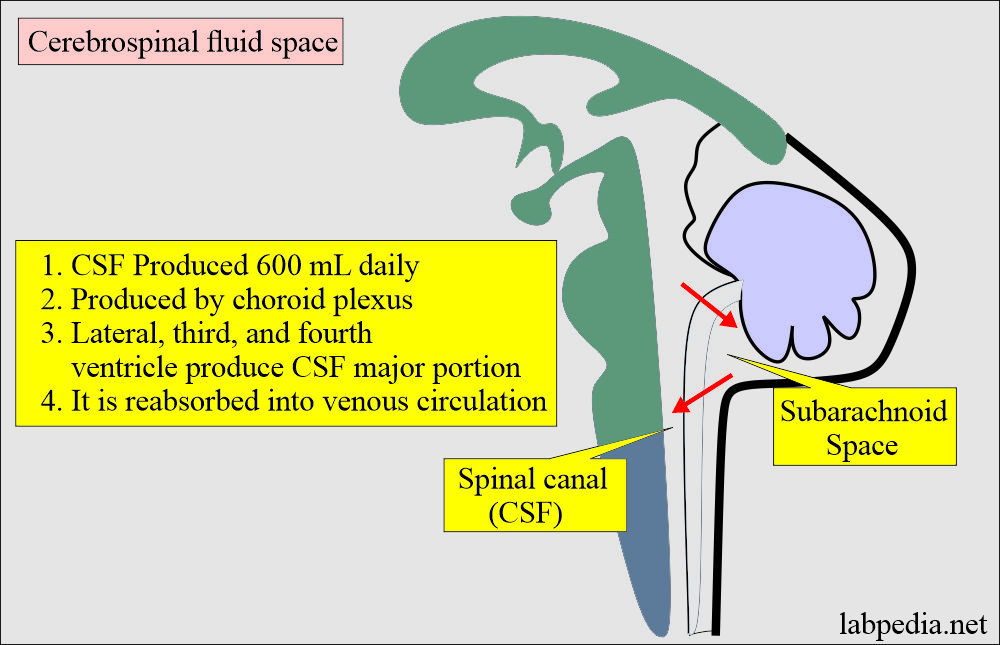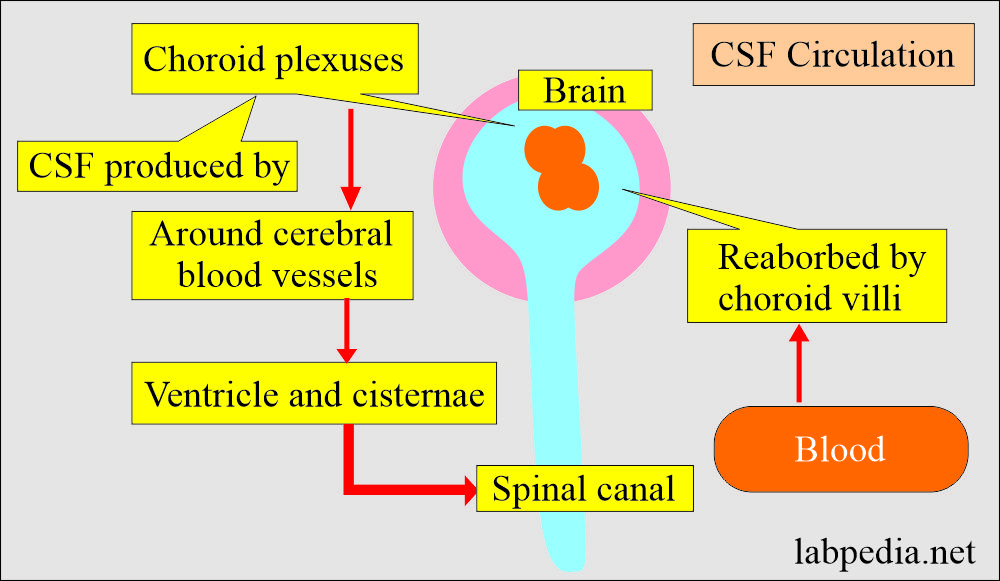Cerebrospinal Fluid Analysis:- Part 1 – Cerebrospinal Fluid (CSF) History and Normal Findings
Cerebrospinal Fluid Analysis (CSF)
History of the cerebrospinal fluid (CSF)
- Cotugno recognized it in 1794; CSF is the third major body fluid.
- CSF provides a physiologic system to supply nutrients to the nervous tissue.
- It removes metabolic wastes.
- It provides a cushion to the brain and spinal cord against trauma.
- The brain and spinal cord are lined by meninges, which consist of:
- The Dura mater is the outer layer.
- The Arachnoid mater is in between the outer and inner layers.
- The Pia mater is the inner layer.
- CSF flows through the arachnoidal space between the arachnoid and pia mater.
- 20 mL of CSF is produced every hour in the choroid plexus and reabsorbed by the arachnoid villi to maintain a total volume of 140 to 170 mL in adults and 10 to 60 mL in neonates.
Definition of the cerebrospinal fluid (CSF)
- It is a clear, colorless fluid similar to blood plasma and interstitial fluid.
- Approximately 600 mL of CSF is produced daily.
- Around 125 to 150 mL of CSF circulates in the ventricles and subarachnoid space.
- The choroid plexus in the lateral, third, and fourth ventricles produces a major portion of the CSF.
- CSF does not accumulate but is reabsorbed into venous circulation through the arachnoid villi.
- The blood forms CSF, and after circulating throughout the CNS, it returns to the blood.
Cerebrospinal fluid (CSF) production:
- CSF is secreted by the choroid plexus, around the cerebral vessels, and along the walls of the brain’s ventricles.
- It fills:
- Ventricle and cisternae.
- Bath the spinal cord.
- It is reabsorbed into the blood through the arachnoid villi.
- CSF turnover is rapid, exchanging about four times/day.
- >80% of the CSF protein contents originate from plasma by ultrafiltration and pinocytosis.
- The rest is from the intrathecal synthesis.
- As the CSF passes down the lumbar region of the spinal space, the protein concentration increases.
Functions of Cerebrospinal Fluid (CSF):
- The intracranial and spinal cord float in the CSF and are protected from blows and jolts.
- The buoyant properties of the CSF prevent the brain from tugging on meninges, Nerve roots, and blood vessels.
- Its primary function is to protect the brain and spinal cord from injury.
- It transports the substances through the central nervous system.
- CSF is the ultrafiltrate of the plasma.
Normal cerebrospinal fluid (CSF):
The appearance of CSF:
- Normal CSF Is clear and colorless.
- This clear CSF circulates in the subarachnoid space.
- No clot is seen.
The pressure of CSF:
- It is 70 to 180 mm H2O or 5 to 14 mm Hg (another reference = 100 to 200 mm H2O).
- This pressure is when the person is lying down and doubles up when the person sits up.
Total cell count in CSF:
- In adults, normal CSF contains 0 to 5 cells/cmm.
- These are mononuclear cells and lymphocytes.
- In newborns, the CSF cell count is 0 to 30/cmm, mostly neutrophils.
- Infants are 0 to 20 cells/cmm.
- No RBC is seen.
The glucose level of CSF:
- It is 45 to 80 mg /dL . The reference value is 45 mg/dL (2.5 mmol/L) or higher.
- In a normal person, it is rare to find glucose below 45 mg/dL.
- CSF glucose is 20 mg /dL lower than the blood glucose level.
- CSF glucose level is around 60% of the serum glucose level.
- In newborns, the CSF glucose level is 80% of the serum glucose level.
- The CSF glucose decrease is important to diagnose the various types of meningitis.
- Ventricular glucose is 5 to 10 mg higher than the lumbar CSF.
The protein level of CSF:
- Normal CSF protein is 15 to 45 mg/dL in lumbar CSF.
- It is 15 to 25 mg/dL in the cisternal fluid.
- It is 5 to 15 mg/dL in the ventricular fluid.
- In the newborn, the values are different and more uncertain.
- At the time of birth is 30 mg/dL, and the range is 75 to 150 mg/dL.
- In infants from 30 days to 90 days, CSF protein is 20 to 100 mg/dL.
- The range from 90 days to 6 months is 15 to 50 mg/dL. The values slowly decline and reach adulthood level by six months of age.
| Age of the patient | Amount of total protein |
| Infants | 30 to 200 mg/dL |
| Child | 14 to 45 mg/dL |
| Adult | 15 to 45 mg/dL |
| Elderly | 15 to 60 mg/dL |
Gamma globulin (CSF):
- It is 3 to 12 % of the total protein.
Chloride (CSF):
- It is from 120 to 130 meq/L.
- It is 20 meq higher than the serum.
LDH (CSF):
- It is 15 to 17 units/L
Bilirubin (CSF):
- It is negative.
Normal Cerebrospinal Fluid Analysis (CSF) findings and normal range from various sources:
| Lab findings | Source 2 | Source 1 | Source 4 |
| Volume |
|
||
| Pressure | <20 cm H2O |
|
|
| Appearance | Clear and colorless, no clot | Crystal clear and colorless | Clear and colorless |
| Blood | Nil | Negative | Nil |
| White cell count |
|
|
|
| Differential count | |||
| Neutrophils | 0 to 6% |
|
|
| Lymphocytes | 40 to 80% |
|
|
| Monocytes | 15 to 45% |
|
|
| Protein |
|
|
|
| Lumbar area |
|
Adult = 15 to 45 mg/dL | |
| Cisternal area | 15 to 25 mg/dL | Adult = 15 to 45 mg/dL = lumbar | |
| Ventricular area | 5 to 15 mg/dL | Adult = 5 to 15 mg/dL | |
| Electrophoresis | |||
| Prealbumin | 2 to 7% | 2 to 7% | |
| Albumin | 56 to 76% | 10 to 35 mg/dL | 56 to 76% |
| Alpha1 globulin | 2 to 7% | 2 to 7% | |
| Alpha2 globulin | 4 to 12% | 4 to 12% | |
| Beta globulin | 8 to 18% | 8 to 18% | |
| Gamma globulin | 3 to 12% | 3 to 12% | |
| IgG | 0 to 4.5 mg/dL | <4.0 mg/dL | |
| Oligoclonal band | Negative | Negative | |
| Biochemical estimation | |||
| Glucose | 50 to 75 mg/dL (60 to 70% of blood glucose) |
|
|
| pH |
|
||
| Sodium | 135 to 160 meq/L | ||
| Potassium | 2.6 to 3.0 meq/L | ||
| Chloride | 700 to 750 mg/dL | 115 to 130 meq/L |
|
| LDH | <2 to 7.2 units/mL | <20 U/L | Adult = <20 U/L (around 10% of serum) |
| Lactic acid | 10 to 25 mg/dL | 10 to 24 mg/dL |
|
| Glutamine | 6 to 15 mg/dL |
|
|
| Urea nitrogen | 6 to 16 mg/dL | ||
| Phosphorus | 1.2 to 2.0 mg/dL | ||
| Creatinine | 0.5 to 1.2 mg/dL | ||
| Uric acid | 0.5 to 4.5 mg/dL | ||
| Bilirubin | Negative | ||
| Ammonia | 10 to 35 µg/dL | ||
| Syphilis serology | Negative | Negative | Negative |
| CSF cytology for malignancy | Negative | Negative | Negative |
Normal CSF summary:
| Characteristics | Normal values |
| Volume |
|
| Appearance |
|
| Total cell count | |
| Adult and children | 0 to 6/cmm, all are mononuclear |
| Infants | <19 /cmm |
| Neonates | <30/cmm |
| Chemistry | |
| Glucose (Lumbar area) |
|
| Total protein | |
| Lumbar area |
|
| Ventricular area | 5 to 15 mg/dL |
| Cisternal area | 15 to 25 mg/dL |
| IgG | <4.0 mg/dL (<10% of total CSF proteins) |
| Chloride | 120 to 130 m eq/L (20 meq/L > than serum value) |
| Sodium | 142 to 150 meq/L |
| Potassium | 2.2 to 3.3 meq/L |
| CO2 | 25 meq/L |
| pH | 7.35 to 7.40 |
| AST (SGOT) | 7 to 49 units |
| Urea nitrogen | 5 to 25 mg/dL |
| Bilirubin | Negative |
| Creatine kinase (CK) | 0 to 5 IU/L |
| Lactate dehydrogenase (LDH) | ∼10% of the serum level |
| CSF electrophoresis | |
| Oligoclonal band | Negative |
| Proteins |
|
| IgG | <4.0 mg/dL (<10% of the total CSF proteins) |
Questions and answers:
Question 1: What is the normal number of WBC in the CSF?
Question 2: What is the normal chloride in the CSF?




These lab summares are excellent. Thank you for providing refresher information. Very informative and helpful.
Thanks for the encouraging comments.
sir please elaborate how to process sample for cytology.
Please let me know what sample of cytology you want to process.
In summary, CSF fluid needs to be centrifuged, and then you can fix the sediment smear with alcohol or other commercial fixatives. Now you can do gram stain, Giemsa stain, or hematoxylin/eosin stain.
Thanks sir
sir i want to process csf cytology and cell counts at my lab, with limited resources.
few queries:
1) can i use leishman stain / pap stain
2) for cell counts can i use improved neubauer cahmber/ hematology analyzer
Dear
You can use Leishman stain (or Giemsa) on the centrifuged sediment of the CSF. For CSF cell count, it depends upon the number of cells. You can use the Neubauer chamber. You can try a Hematology analyzer; compare the count with the Neubauer chamber.
thank you sir